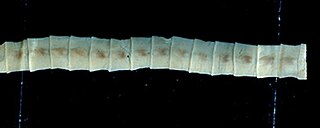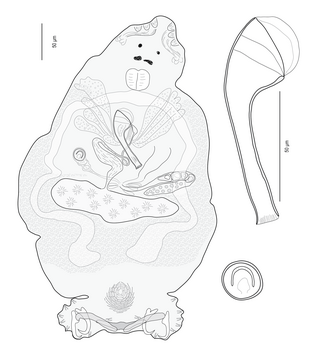Related Research Articles

The Caryophyllideans are a group of tapeworms that infect fish and annelids with a simple scolex or "head." Worms in this order only have one proglottid, which is believed to be the primitive condition for tapeworms. They are generally less than 10 centimetres long. Caryophillideans represent a unique type of tapeworm, such that they possess a monzoic, unsegmented, body, with only a single set of reproductive organs.

The Terebellidae is a marine family of polychaete worms, of which the type taxon is Terebella, described by Carl Linnaeus in his 1767 12th edition of Systema Naturae.

The pale-edged stingray or sharpnose stingray is a species of stingray in the family Dasyatidae, found in the Indian and Pacific Oceans from India to the western Malay Archipelago and southern Japan. This bottom-dwelling ray is most commonly found over sandy areas shallower than 100 m (330 ft), as well as in estuaries. Measuring up to 29 cm (11 in) across, the pale-edged stingray has a diamond-shaped pectoral fin disc, a long projecting snout, small eyes, and a whip-like tail with both dorsal and ventral fin folds. It is chocolate brown above and white below.

Oligacanthorhynchida is an order containing a single parasitic worm family, Oligacanthorhynchidae, that attach themselves to the intestinal wall of terrestrial vertebrates.

Raillietina is a genus of tapeworms that includes helminth parasites of vertebrates, mostly of birds. The genus was named in 1920 in honour of a French veterinarian and helminthologist, Louis-Joseph Alcide Railliet. Of the 37 species recorded under the genus, Raillietina demerariensis, R. asiatica, and R. formsana are the only species reported from humans, while the rest are found in birds. R. echinobothrida, R. tetragona, and R. cesticillus are the most important species in terms of prevalence and pathogenicity among wild and domestic birds.

Microcotyle is a genus which belongs to the phylum Platyhelminthes and class Monogenea. Species of Microcotyle are ectoparasites that affect their host by attaching themselves as larvae on the gills of the fish and grow into adult stage. This larval stage is called oncomiracidium, and is characterized as free swimming and ciliated.
Aggregata is a genus of parasitic alveolates belonging to the phylum Apicomplexa.
Oochoristica is a genus of tapeworms.

Opecoelidae is a family of trematodes. It is the largest digenean family with over 90 genera and nearly 900 species, almost solely found in marine and freshwater teleost fishes. It was considered by Bray et al. to belong in the superfamily Opecoeloidea Ozaki, 1925 or the Brachycladioidea Odhner, 1905.

Lethrinus atkinsoni, the Pacific yellowtail emperor,, Atkinson's emperor, reticulated emperor, tricky snapper, Tuamotu emperor, yellow morwong or yellow-tailed emperor is a species of marine ray-finned fish benomging to the family Lethrinidae, the emperor breams and emperors. This fish is found in the Western Pacific Ocean.

Lethrinus nebulosus, the spangled emperor, green snapper, morwong, north-west snapper, sand bream, sand snapper, sixteen-pounder, sharie, sheri and yellow sweetlip, is a species of marine ray-finned fish belonging to the family Lethrinidae, the emperors and emperor breams. This species is found the Indo-West Pacific region.

Lethrinus rubrioperculatus,the spotcheek emperor, red-eared emperor, red-ears, red-edged emperor, scarlet-cheek emperor, and spot cheek emperor, is a species of marine ray-finned fish belonging to the family Lethrinidae, the emperors or emperor breams. This species has a wide Indo-Pacific distribution.

The Diplectanidae are a family of monopisthocotylean monogeneans. They are all parasitic on the gills of fish. Diplectanids are small animals, generally around 1 mm in length. As parasites, they can be extremely numerous, up to several thousand on an individual fish.
Diphyllidea is a monotypic order of Cestoda (tapeworms). Members of this order are gut parasites of elasmobranch fishes including rays and sharks. Disphyllidea infect their host’s spiral intestine. Scolex is the type of tapeworm associated with Disphyllidea, which have a hook-like structure that helps attach to their host’s gut.

Chimaericola is a genus of parasitic flatworms in the family Chimaericolidae. The genus was created by August Brinkmann in 1942. Species are parasitic on the gills of chimaeras.

Diphyllobothriidae is a family of Cestoda (tapeworms). Members of this family are gut parasites of vertebrates. In most species the definitive hosts are marine or aquatic mammals such as cetaceans and pinnipeds, the first intermediate host usually being a crustacean and the second intermediate a fish. The genus Diphyllobothrium is found as an adult in mammals and fish-eating birds, including the domestic cat. The genus Spirometra tends to have a land-dwelling or semi-aquatic vertebrate as its second intermediate host, with the adults usually occurring in felines.
Aethycteron is a genus of monogeneans belonging to the family Ancyrocephalidae. All members of the genus are parasitic on fish. The generic name is derived from the Greek aithycteros, meaning "darter", due to the fact that its members have been found infecting darters.

Laticola is a genus of monopisthocotylean monogeneans, belonging to the family Diplectanidae. All known species are parasitic on the gills of marine fish, including members of Lates (Latidae) and Epinephelus (Serranidae).

Enterogyrus is a genus of monogeneans belonging to the family Ancyrocephalidae.
Cynoscionicola is a genus which belongs to the family Microcotylidae and class Monogenea. Species of Cynoscionicola are ectoparasites that affect their host by attaching themselves as larvae on the gills of the fish and grow into adult stage. This larval stage is called oncomiracidium, and is characterized as free swimming and ciliated. This genus was proposed by Price in 1962, to accommodate Cynoscionicola heteracantha and Cynoscionicola pseudoheteracantha . Members of Cynoscionicola are characterised by a genital atrium with two anterior muscular pockets armed with single row of hooked spines, and two posterior lateral muscular pouches armed with spines.
References
- 1 2 Leuckart R. 1878. Archigetes sieboldi, eine geschlechtsreife Cestodenamme. Zeitschrift für Wissenschaftliche Zoologie, 30 (Suppl.), 593–606.
- ↑ WoRMS (2021). Archigetes Leuckart, 1878. Accessed at: http://www.marinespecies.org/aphia.php?p=taxdetails&id=1511810 on 2022-01-14
- ↑ Mrázek A. 1908. Ueber eine neue Art der Gattung Archigetes. Zentralblatt für Bakteriologie und Parasitenkunde. 46, 719–723.
- ↑ Wiśniewski LW. 1928. Archigetes cryptobothrius n. sp. nebst Angaben die Entwicklung im Genus Archigetes, R. Leuck. Zoologischer Anzeiger, 77, 113-124.
- ↑ Calentine RL. 1962. Archigetes iowensis sp. n. (Cestoda: Caryophyllaeidae) from Cyprinus carpio L. and Limnodrilus hoffmeisteri Claparède. Journal of Parasitology, 48, 513–524
- ↑ Kennedy CR. 1965. Taxonomic studies on Archigetes Leuckart, 1878 (Cestoda, Caryophyllidea). Parasitology, 55, 439–451.